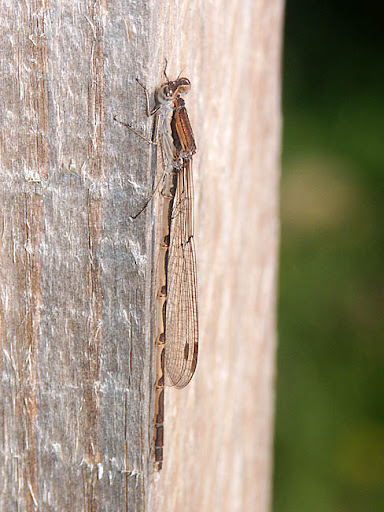Scientific Name: Sympecma fusca.
English Name: Common Winter Damselfly.
French Name: Le Leste brun.
 5 Key Characters:
5 Key Characters:
Habitat: Unpolluted, well-vegetated stagnant water, especially if there is floating vegetation - ponds, fish ponds (étangs), lakes, marshes, temporary pools, oxbow lakes. Sunny forest clearings, fallow land. A lowland species. The adults hibernate under stones, in dry grass, moss, litter, reeds and bark.
Flight Period: All year, but the peak is April and May. Juveniles, with their coppery sheen, are often very visible in the autumn.
Status: Common, but for this situation to continue lake water must be free of agricultural pollution, pisciculture must not be over exploited. The winter cutting of reeds, too dense a growth of riverbank trees and the destruction of forest undergrowth also impacts by reducing their winter hibernation sites.
More Info:
Common Winter Damselfly Sympecma fusca on Days on the Claise.
Photographed by Loire Valley Nature:
Photos are numbered from left to right and top to bottom. 1 February. 2-3 March.



English Name: Common Winter Damselfly.
French Name: Le Leste brun.
 5 Key Characters:
5 Key Characters:- Pale brown body with dark brown markings.
- Drab and extremely well camouflaged so easy to overlook.
- Thick straight dark brown lengthwise stripes on the thorax.
- A medium sized damselfly (34-39mm long).
- Can be seen in any month of the year.
Habitat: Unpolluted, well-vegetated stagnant water, especially if there is floating vegetation - ponds, fish ponds (étangs), lakes, marshes, temporary pools, oxbow lakes. Sunny forest clearings, fallow land. A lowland species. The adults hibernate under stones, in dry grass, moss, litter, reeds and bark.
Flight Period: All year, but the peak is April and May. Juveniles, with their coppery sheen, are often very visible in the autumn.
Status: Common, but for this situation to continue lake water must be free of agricultural pollution, pisciculture must not be over exploited. The winter cutting of reeds, too dense a growth of riverbank trees and the destruction of forest undergrowth also impacts by reducing their winter hibernation sites.
More Info:
Common Winter Damselfly Sympecma fusca on Days on the Claise.
Photographed by Loire Valley Nature:
Photos are numbered from left to right and top to bottom. 1 February. 2-3 March.









No comments:
Post a Comment